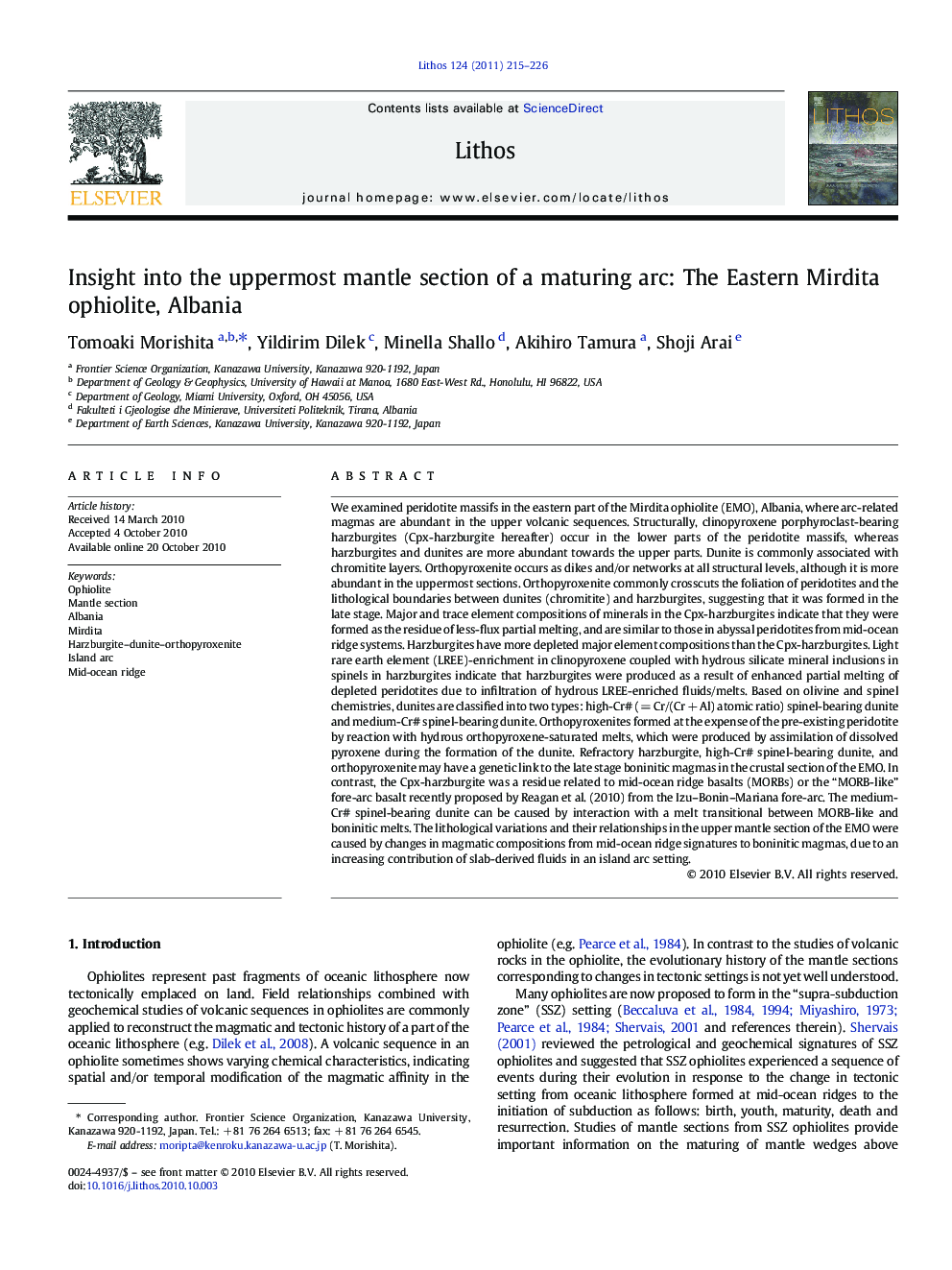| کد مقاله | کد نشریه | سال انتشار | مقاله انگلیسی | نسخه تمام متن |
|---|---|---|---|---|
| 4716763 | 1638720 | 2011 | 12 صفحه PDF | دانلود رایگان |
عنوان انگلیسی مقاله ISI
Insight into the uppermost mantle section of a maturing arc: The Eastern Mirdita ophiolite, Albania
دانلود مقاله + سفارش ترجمه
دانلود مقاله ISI انگلیسی
رایگان برای ایرانیان
کلمات کلیدی
موضوعات مرتبط
مهندسی و علوم پایه
علوم زمین و سیارات
ژئوشیمی و پترولوژی
پیش نمایش صفحه اول مقاله

چکیده انگلیسی
We examined peridotite massifs in the eastern part of the Mirdita ophiolite (EMO), Albania, where arc-related magmas are abundant in the upper volcanic sequences. Structurally, clinopyroxene porphyroclast-bearing harzburgites (Cpx-harzburgite hereafter) occur in the lower parts of the peridotite massifs, whereas harzburgites and dunites are more abundant towards the upper parts. Dunite is commonly associated with chromitite layers. Orthopyroxenite occurs as dikes and/or networks at all structural levels, although it is more abundant in the uppermost sections. Orthopyroxenite commonly crosscuts the foliation of peridotites and the lithological boundaries between dunites (chromitite) and harzburgites, suggesting that it was formed in the late stage. Major and trace element compositions of minerals in the Cpx-harzburgites indicate that they were formed as the residue of less-flux partial melting, and are similar to those in abyssal peridotites from mid-ocean ridge systems. Harzburgites have more depleted major element compositions than the Cpx-harzburgites. Light rare earth element (LREE)-enrichment in clinopyroxene coupled with hydrous silicate mineral inclusions in spinels in harzburgites indicate that harzburgites were produced as a result of enhanced partial melting of depleted peridotites due to infiltration of hydrous LREE-enriched fluids/melts. Based on olivine and spinel chemistries, dunites are classified into two types: high-Cr# (= Cr/(Cr + Al) atomic ratio) spinel-bearing dunite and medium-Cr# spinel-bearing dunite. Orthopyroxenites formed at the expense of the pre-existing peridotite by reaction with hydrous orthopyroxene-saturated melts, which were produced by assimilation of dissolved pyroxene during the formation of the dunite. Refractory harzburgite, high-Cr# spinel-bearing dunite, and orthopyroxenite may have a genetic link to the late stage boninitic magmas in the crustal section of the EMO. In contrast, the Cpx-harzburgite was a residue related to mid-ocean ridge basalts (MORBs) or the “MORB-like” fore-arc basalt recently proposed by Reagan et al. (2010) from the Izu-Bonin-Mariana fore-arc. The medium-Cr# spinel-bearing dunite can be caused by interaction with a melt transitional between MORB-like and boninitic melts. The lithological variations and their relationships in the upper mantle section of the EMO were caused by changes in magmatic compositions from mid-ocean ridge signatures to boninitic magmas, due to an increasing contribution of slab-derived fluids in an island arc setting.
ناشر
Database: Elsevier - ScienceDirect (ساینس دایرکت)
Journal: Lithos - Volume 124, Issues 3â4, June 2011, Pages 215-226
Journal: Lithos - Volume 124, Issues 3â4, June 2011, Pages 215-226
نویسندگان
Tomoaki Morishita, Yildirim Dilek, Minella Shallo, Akihiro Tamura, Shoji Arai,